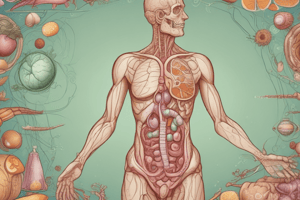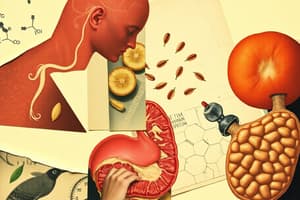Podcast
Questions and Answers
Which of the following is NOT a role of proteins in the body?
Which of the following is NOT a role of proteins in the body?
- Transport
- Thermoregulatory (correct)
- Catalytic
- Structural
What is considered a positive nitrogen balance?
What is considered a positive nitrogen balance?
- Nitrogen intake equals nitrogen output.
- More nitrogen is gained than lost. (correct)
- More nitrogen is lost than gained.
- Nitrogen cannot be accurately measured.
During protein digestion, what substance is secreted by parietal cells in the stomach?
During protein digestion, what substance is secreted by parietal cells in the stomach?
- Pepsin
- Bile salts
- Hydrochloric acid (correct)
- Trypsinogen
What is the daily requirement of protein for a healthy adult?
What is the daily requirement of protein for a healthy adult?
Which enzyme acts specifically on peptide bonds at the carboxy-terminal end?
Which enzyme acts specifically on peptide bonds at the carboxy-terminal end?
Which statement is true about dietary protein digestion?
Which statement is true about dietary protein digestion?
What is the half-renewal time of proteins in the body?
What is the half-renewal time of proteins in the body?
Which amino acid is missing from the protein of maize?
Which amino acid is missing from the protein of maize?
Flashcards
Protein Functions
Protein Functions
Proteins play crucial roles in building and maintaining structures, facilitating biochemical reactions, transporting molecules, regulating cellular processes, protecting against harm, maintaining bodily balance, and storing nutrients.
Protein Digestion
Protein Digestion
The process of breaking down proteins into smaller units, primarily amino acids, in the digestive system.
Endopeptidases
Endopeptidases
Enzymes that break peptide bonds within a protein molecule, shortening the protein chain.
Exopeptidases
Exopeptidases
Signup and view all the flashcards
Pepsin
Pepsin
Signup and view all the flashcards
Trypsin
Trypsin
Signup and view all the flashcards
Carboxypeptidase
Carboxypeptidase
Signup and view all the flashcards
Aminopeptidase
Aminopeptidase
Signup and view all the flashcards
Study Notes
Protein Digestion Overview
- Dietary protein intake is 50-100 g/day
- Proteins are denatured during cooking which makes them easier to digest
- Protein absorption is highly efficient in healthy humans with minimal loss in feces (5-10 g/day)
Protein Roles in the Body
- Structural: Provides support and shape to tissues
- Catalytic: Acts as enzymes to catalyze biochemical reactions
- Transport: Carries molecules throughout the body
- Regulatory: Controls various cellular activities
- Protective: Protects against damage
- Homeostatic: Maintains internal balance
- Accumulating: Involved in storage
Protein Metabolism Dynamics
- Daily protein hydrolysis is ~400 g
- Daily protein synthesis is ~400 g
- Daily protein requirements are ~100 g
- Protein half-renewal time is 80 days
Protein Metabolism Index: Nitrogen Balance
- Positive nitrogen balance: Nitrogen gained exceeds lost (children)
- Negative nitrogen balance: Nitrogen lost exceeds gained (elderly, chronic diseases)
- Nitrogen balance/equilibrium: Nitrogen intake equals nitrogen output (healthy adults)
Protein Content in Food
- Various food items provide different amounts of protein, both plant-based and animal-based
- Tables detailing this are presented
Essential & Non-Essential Amino Acids
- Essential amino acids cannot be synthesized in the body and must be obtained from food
- Non-essential amino acids can be synthesized in the body
- A list of essential and non-essential amino acids is provided
- Important amino acids for muscle formation fall between 30-40% of the essential amino acids.
Food Products Lacking Essential Amino Acids
- Some plant proteins are deficient in certain essential amino acids
- Proteins of maize lack lysine
- Proteins of soybean lack tryptophan
Protein Digestion Processes
- Stomach:
- Gastric juice contains hydrochloric acid (HCl) and pepsinogen
- Parietal cells secrete HCl, lowering stomach pH (<2)
- HCl denatures proteins and kills microorganisms
- Optimum pH for pepsin activity is around 2
- Pepsinogen is converted into pepsin by cleaving of 44 amino acids from the N-terminal end by HCl
- Pepsin is an endopeptidase that catalyzes hydrolysis of peptide bonds formed by carboxyl groups of phenylalanine (Phe), tyrosine (Tyr), tryptophan (Trp), and methionine (Met).
- Rennin (chymosin) is present in infants and children to convert milk protein casein into solid calcium paracaseinate.
- Small Intestine:
- Denatured & partially hydrolyzed proteins
- Protease activity
- Various proteolytic enzymes (e.g. trypsin, chymotrypsin, elastase) for continued protein breakdown
- Endopeptidases Act on peptide bonds inside the protein molecule; smaller & smaller units
- Exopeptidases Act on the peptide bonds at the ends of the chain; carboxypeptidase and aminopeptidase
- Carboxypeptidase acts on the carboxyl terminal end
- Aminopeptidase acts on the amino terminal end
- Intestinal Lumen:
- Aminopeptidases and dipeptidases within intestinal epithelial cells
- Aminopeptidase is a non-specific exopeptidase that cleaves N-terminal amino acids one by one
- Digested Protein Absorption:
- Amino acids enter the capillary blood in the villi and the hepatic portal vein to the liver
Pancreatic Digestion
- Optimal pH for pancreatic enzymes is around 8 provided by alkaline pancreatic juice
- Cholecystokinin and secretin stimulate pancreatic juice secretion & enzyme release
- Secretion in the stomach and pancreas are regulated by hormones (secretin)
- Pancreatic juice contains endopeptidases (trypsin, chymotrypsin, elastase) and exopeptidases (carboxypeptidases)
- Enzymes are secreted as inactive zymogens & stimulated to active form
Intestinal Digestion of Proteins
- Aminopeptidases and dipeptidases are on the luminal surface of intestinal epithelial cells
- Dipeptidases act on peptides
- Aminopeptidase is a non-specific exopeptidase (cleaves N-terminal amino acids) to form free-amino-acids
Amino Acid Absorption
- Absorption mainly in the small intestine which requires energy
- 5 different carrier systems for amino acids: Neutral, basic, immino, acidic, and beta-amino
- Na+ dependent active process; Na+ diffuses maintaining a gradient & driving active amino acid transport
Toxic Substance Formation
- Formation of toxic substances from amino acids in the colon from bacterial enzymes
- Hydroxylation of toxic substance in the liver, from indoxyl, skatole, & indoxyl hydroxysulfate
Diagnostic Value of Indican in Urine
- Serum and urine indican levels can indicate various conditions (e.g., intestinal obstruction, renal failure)
Overview of specific enzymes for protein digestion
- Pepsin
- Trypsin
- Chymotrypsin
- Elastase
- Carboxypeptidase A
- Carboxypeptidase B
- aminopeptidase
- Dipeptidases and tripeptidases
Studying That Suits You
Use AI to generate personalized quizzes and flashcards to suit your learning preferences.




